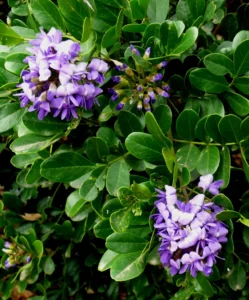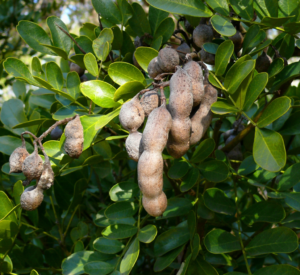Author: Bill Ward
During 2010, Operation NICE! (Natives Instead of the Common Exotics!) will feature 10 of the most popular and successful of past NICE! Plants of the Month. The NICE! Committee members voted for their favorites among the nominees in several categories: trees, shrubs, flowers, vines, and grasses.
The winners: January, mountain laurel; February, redbud; March, coral honeysuckle; April, American beautyberry; May, esperanza; June, Turk’s cap; July/August, Lindheimer muhly; September, blue mist flower; October, salvias; and November/December, possumhaw.

All of these 10 for 2010 bear repeating for at least two reasons. For one thing, these plants have proven to be hardy water-conserving landscape plants that do well in this area and generally are readily available at local nurseries.
Another reason it is time to reintroduce a few of the NICE! favorites is that during the nearly eight years of our NICE! program, many new people have moved to the Boerne area, and a lot of them need landscaping tips. And, I am happy to say, an increasing number of longtime residents have become interested in planting landscape vegetation that requires less water, fertilizer, and pesticides.
The January NICE! plant, Texas mountain laurel (Sophora secundiflora), was our very first Plant of the Month in April 2002. This flowering evergreen shrub or small tree has been a favorite plant for home and commercial landscaping in this region for a long time.
Texas mountain laurel is the native plant I most associate with my childhood. When I grew up in San Antonio, the most ubiquitous yard shrubs, as I remember it anyway, were ligustrum, abelia, vitex, Japanese plum (temporarily changed to “Chinese plum” during WWII), and mountain laurel. In those days, I certainly wouldn’t have understood how unfortunate that four out of those five were exotics.

Even then, however, I did have a sense that it was highly desirable to have a mountain laurel in your yard. For one thing, in early spring it puts out fragrant blooms that look like hanging clusters of purple grapes. People with more sensitive noses than mine said the blooms smelled like Grapette and grape Kool-Aid.
In elementary school I had at least one teacher who would get a little perturbed when a student brought her a gift of mountain laurel flowers. She immediately would put them on an open-window sill or even out in the hall when it was too cold for open windows. Because of that teacher, for many years I thought people would pass out if closed up in a room with mountain laurel flowers.
When we ambled home from elementary school, it was always fun to search the ground under a mountain laurel for the hard red “laurel beans.” We never got tired for rubbing a bean on the sidewalk until the friction made it hot, then sneaking up to touch it to the bare skin of a friend and yelling, “Red hot!”
Of course, at that time I had no idea these mountain laurel seeds also are called mescal beans and once were ground into powder by Native Americans to use in hallucinogenic ceremonial potions. Reportedly, when it was discovered the toxic mescal beans were killing people, they switched to peyote.

Homeowners in my childhood neighborhood undoubtedly sought out Texas mountain laurel to plant in their yards because it has bright-green evergreen foliage, pretty purple flowers, and grows well in calcareous soils. The perfect shrub for much of San Antonio and the eastern Hill Country. Today we also pay special attention to the fact it is so drought tolerant and is rarely browsed by deer.
Except for very small seedlings, I find mountain laurels difficult to transplant. However, they are widely available at nurseries in a range of sizes. Once established, Texas mountain laurel never needs irrigation. The Boerne Chapter of the Native Plant Society of Texas provides free planting and care instructions for Texas mountain laurel at nurseries participating in Operation NICE! (Hill Country African Violets and Nursery, Maldonado Landscape and Nursery, and Medina Garden Nursery) and at Cibolo Nature Center.
As a boy in San Antonio and much later as a homeowner in the Boerne area, I always regarded Texas mountain laurel as one of the most desirable Texas natives, a really special little tree. I haven’t changed my mind, but in the last few years I have been surprised to learn that Texas mountain laurel can be seen in a very different light. Not far west of here in limestone hills of Real and Uvalde Counties there are dense thickets of mountain laurel that have the same effect as the thickest Ashe juniper (cedar) brakes. Practically no grasses and forbs can grow in those areas because of low light and dry soil. For ranchers in those areas, mountain laurel is more of a dreaded nuisance than cedar.
In our part of the Hill Country, thank goodness, Texas mountain laurel is better behaved. It is one of our top yard plants. Quite a NICE! shrub.


